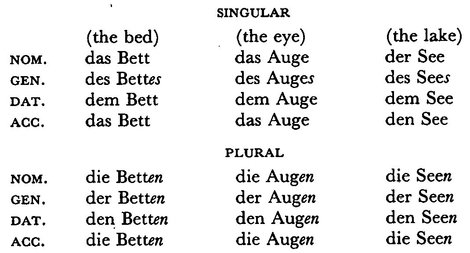Nouns
Using Nouns in German
In English sentences, you generally add endings on nouns in two situations: to form possessives and to form plurals. You add -’s to most nouns to indicate possession (ship’s bell, girl’s dress, etc.) and -s or -es to form the plural (birds, watches, hands, etc.).
The same general principles hold in German, but the rules are more complex. There are more endings, and more occasions when endings are added. The mechanics of declension, however, are not as difficult as they are said to be, and with the aid of a few rules you can master them easily.
In German there are five important ways (or declensions) in which nouns take endings and you must know to which declension a noun belongs before you can use it properly. (In English almost all nouns take -s or -es to form their plural, but there are remnants of other declensions in such words as ox, oxen; man, men; sheep, sheep, which form their plurals in other ways.)
There are no watertight rules for knowing which nouns belong to which declension, but there are good general hints which will lead you to the proper ending most of the time. Before you study the five declensions, learn these rules, because it has been estimated that they cover more than 95% of the words you are likely to use, and with them, you will be able to handle most German nouns without looking at involved tables of declension.
Rule1. Feminine nouns never take endings to form their singular cases. They use the same form for nominative, genitive, dative, and accusative.
| (the typewriter) | (the street) | |
| NOM. | die Schreibmaschine | die Strasse |
| GEN. | der Schreibmaschine | der Strasse |
| DAT. | der Schreibmaschine | der Strasse |
| ACC. | die Schreibmaschine | die Strasse |
Rule 2. All neuter nouns and almost all masculine nouns require only one ending in the singular. This is -s or -es, which is added to the noun to form the genitive. (It is true that some masculine and neuter nouns that are only one syllable long can add -e to form the dative singular, but this ending is optional and can be ignored.)
| (the shoe) masc. | (the shirt) NEUT. | |
| NOM. | der Schuh | das Hemd |
| GEN. | des Schuhes | des Hemdes |
| DAT. | dem Schuh | dem Hemd |
| ACC. | den Schuh | das Hemd |
Rule 3. Masculine nouns designating living beings usually add -n to form all other cases, both singular and plural, if the nominative singular ends in -e.
| SING. (the lion[s]) | PL. | |
|---|---|---|
| NOM. | der Löwe | die Löwen |
| GEN. | des Löwen | der Löwen |
| DAT. | dem Löwen | den Löwen |
| ACC. | den Löwen | die Löwen |
Rule 4. All dative plural forms end in -n or -en.

Rule 5. In the respective plurals of all declensions and all genders, the nominative, genitive, and accusative always have identical forms.

To form the dative plural of the above nouns, add -(e)n to the nominative plural of the noun, unless the nominative plural already ends in -(e)n. If the nominative plural ends in -(e)n, then the dative plural will be identical with the nominative, genitive, and accusative plural forms. Thus the dative plural of the above nouns is, respectively, den Wäldern, den Birnen, den Tüchern.
Noun Groups
Every German noun belongs to one of five declensions, and its endings change according to the declension to which it belongs. Although most singular forms can be determined by the first three rules in the preceding section, plural forms are more complex. While there are no simple or exhaustive rules for determining what plural form a noun will take, there are some general rules which may make memorization of forms easier for you.
Group I. The characteristic of this declension is that it takes no endings for its plural forms, except for the necessary -n in the dative (see rule 4, p. 17). An umlaut is often added to the stem vowel to make the plural forms.* Singular forms follow the rules given in the preceding section.
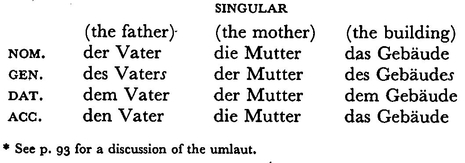

Some nouns that belong to Group I: most nouns whose nominative singular ends in -el, -en, or -er; neuter nouns that begin with Ge- and end in -e.
Group II. The nouns that belong to this declension add -e (-en in the dative) to form their plurals. They sometimes umlaut their stem vowel in the plural. Singular forms follow the three rules given on pp. 16–17.
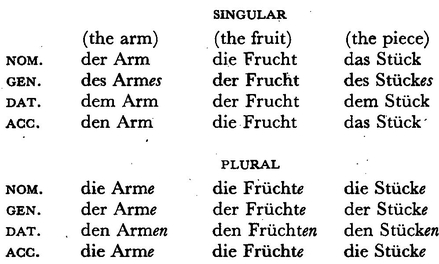
Nouns that belong to Group II: most masculine nouns that are one syllable long; about half the feminine and neuter nouns that are one syllable long.
Group III. Nouns in this group add -er (-ern in the dative) to form their plurals, and place an umlaut over the vowel wherever possible. Singular forms follow the three rules given on pp. 16–17.
| SINGULAR | ||
| (the man) | (the glass) | |
| NOM. | der Mann | das Glas |
| GEN. | des Mannes | des Glases |
| DAT. | dem Mann | dem Glas |
| ACC. | den Mann | das Glas |
| PLURAL | ||
| NOM. | die Männer | die Gläser |
| GEN. | der Männer | der Gläser |
| DAT. | den Männern | den Gläsern |
| ACC. | die Männer | die Gläser |
Nouns that belong to Group III: many neuter nouns that are only one syllable long. There are no feminine nouns in this group.
Group IV. This is sometimes called the weak declension of nouns. Nouns in this group add -n or -en to form all plurals,—nominative, genitive, dative, and accusative. The feminine singular forms take no ending, as explained in Rule 1 on p. 16. Masculine singular nouns add -en to form all cases except the nominative, and often fit Rule 3, p. 17. None of the nouns in this group ever umlaut the stem vowel in the plural.
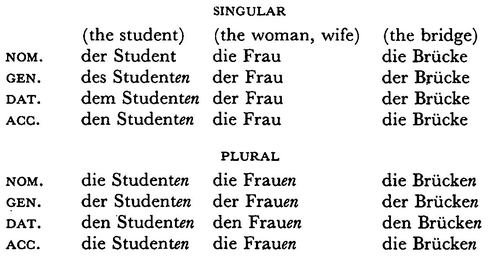
Nouns that belong to Group IV: most feminine nouns that are more than one syllable long; most masculine nouns denoting living things. There are no neuter nouns in this group.
Group V. This small group includes nouns of foreign origin. They are declined similarly to English nouns, with -s for the genitive singular, and -s for the plural.
| SING. (the auto) | PL. | |
|---|---|---|
| NOM. | das Auto | die Autos |
| GEN. | des Autos | der Autos |
| DAT. | dem Auto | den Autos |
| ACC. | das Auto | die Autos |
Other common words in this group are das Radio, das Hotel, and das Restaurant.
Irregular Nouns
There are a few nouns whose declension in the genitive singular is irregular. The irregularity consists of their adding -ns or -ens to form the genitive singular, instead of adding only -s or -es, according to Rule 2, p. 17. The plurals of these nouns are formed by adding -n or -en to the stem of the noun, and all the plural forms are identical. It may help you to think of these nouns as belonging to Group IV, as far as their plural forms are concerned. The three most common nouns of this type are given below:
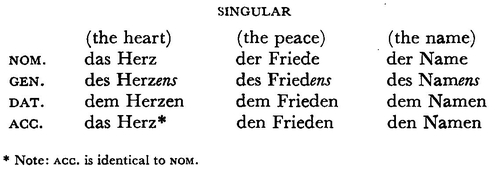

As you can see, the plural of these two nouns is regular, that is, they use the form of the nominative plural throughout.
Mixed Declensions
A few nouns use the typical -s or -es for the genitive singular ending, in accordance with Rule 2, but form their plurals as if they belonged to Group IV, that is by adding -n or -en to the noun stem and using the same form throughout the plural. Das Bett is a typical mixed-declension noun to use as a model.
